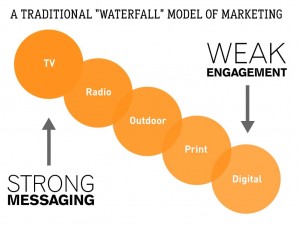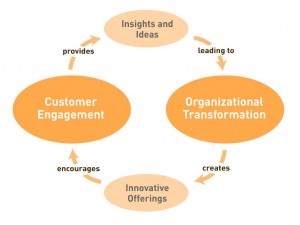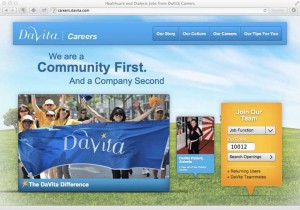A customer-centric approach to marketing provides transformative potential for organizations
Overview
In our increasingly digital world, it is a truism to say that traditional models of advertising and marketing are insufficient to the task at hand. But what does this mean, if anything?
Engagement is the buzzword of the day, and organizations and agencies are falling over themselves to figure out how to connect with their audience through social platforms and mobile applications. Advertising campaigns are augmented with interactivity (albeit often as an afterthought), and ‘content marketing’ is breaking down the line between advertising and storytelling. In some cases crowdsourced content has become intrinsic to the story, most famously leveraged in Weiden+Kennedy’s Old Spice campaign (though there are numerous other examples out there).
All this is good, and important, and often fun. Building digital brand engagement is an essential component to contemporary marketing campaigns. But it’s only half of the equation. Clear back in 1999, the first thesis of the Cluetrain Manifesto was that “markets are conversations.†By definition, a conversation has to go both ways; it’s not enough to encourage your customer to act as a megaphone. And the other side of the conversation (when it comes to customer engagement) is organizational transformation.
From the agency perspective, there is as much or more opportunity in helping clients to build increasingly valuable relationships with their customers than there is in just promoting their existing products and services, and this opportunity is especially pertinent for agencies with their roots in digital. Taking advantage of this opportunity requires a radical reconsideration both of the role of the agency and of the purpose and methods of marketing. At the end of the day, in some ways it hasn’t changed at all; agencies are still building brands, making connections, and telling stories. It’s just that the nature of the stories is different.
A Traditional Model of Advertising
“I don’t believe in duping the public, but I believe in first attracting and then pleasing them.â€
P.T. Barnum, American Entrepreneur and Showman
 At the most fundamental level, effective marketing has always been rooted in understanding the customer (or potential customer) and providing them the information to make an educated decision. Naturally, there is an element of the showman and entertainer as part of the process. We want to be part of brands that represent the aspirational parts of ourselves, that seduce us and make us feel connected and clever and witty and better looking. But, you still have to deliver the goods; a brand promise is only as good as the ability to deliver on the that promise. The worst of advertising comes from setting false expectations. As P.T. Barnum said, you have to attract them first, and then please them.
At the most fundamental level, effective marketing has always been rooted in understanding the customer (or potential customer) and providing them the information to make an educated decision. Naturally, there is an element of the showman and entertainer as part of the process. We want to be part of brands that represent the aspirational parts of ourselves, that seduce us and make us feel connected and clever and witty and better looking. But, you still have to deliver the goods; a brand promise is only as good as the ability to deliver on the that promise. The worst of advertising comes from setting false expectations. As P.T. Barnum said, you have to attract them first, and then please them.
In the mass marketing era which has defined the bulk of the last 60-plus years (and which we are arguably on the tail end of), campaigns focused primarily on broadcast television, radio, and newspaper ads. According to this model, getting a product adopted requires taking creative (or not so creative) ideas and putting them out there with sufficient frequency and reach to hit the audience. It’s a one-way push model, it moves from from the top down, and it’s more or less one size fits all.
The traditional components of the marketing model aren’t going away; creative ideas and design are as important now as they have ever been. But the advent of digital culture has changed the equation fundamentally.
Building Engagement
 Social, mobile, local. Organizations (and their agencies) are looking for any opportunity to engage with customers and potential customers, encouraging them to promote their brand and tell their story. The drivers to adopt these approaches are numerous, as the methods of media distribution and engagement change radically and fundamentally. In this environment, engagement models have become an essential part of the process as we seek to understand customer behavior and touchpoint opportunities.
Social, mobile, local. Organizations (and their agencies) are looking for any opportunity to engage with customers and potential customers, encouraging them to promote their brand and tell their story. The drivers to adopt these approaches are numerous, as the methods of media distribution and engagement change radically and fundamentally. In this environment, engagement models have become an essential part of the process as we seek to understand customer behavior and touchpoint opportunities.
But too often the drive for engagement is a superficial add-on to the traditional marketing cycle. Concepts come from broadcast and print and are then extended to serve the interactive opportunities (“Add your thoughts on Facebook!â€). Or, unique interactive content is created with the primary intention of developing a case study or video to tell the story later. Consider Google’s “Project Re: Brief†Coke ad, as imaginative and technically innovative as it is, was never going to fundamentally change google’s business. It was designed from the start as a “behind the scenes†video with no intention of rolling it out more broadly.
Though engagement should be more than an afterthought to an idea or an opportunity for a sound bite, it’s more difficult than it first appears to build a framework that includes the audience in the process. What is traditionally one-way has to become a two-way, a highly controlled presentation of ideas has to become a conversation. This is always a challenge for organizations, who want to present as consistent and unblemished a picture of themselves as possible, and also for their agency partners, who want to tell the story without interference or distractions.
The Transformational Imperative
“Improving marketing productivity is about more than improving ROI on marketing campaigns. It requires rethinking people, processes, systems and product portfolios.â€
– Mohan Sawhney, Professor of Technology at Kellogg School of Management at Northwestern University
Professor Mohan Sawhney of Northwestern University is a leading advocate of taking a customer-centric approach to business. In a talk from 2010 on this topic (available on youtube), he recommends that organizations align themselves with the “three pillars of customer-centricityâ€:
- Getting a superior understanding of customers (better customer insights).
- Using these insights to come up with a superior value proposition
- Delivering a superior customer experience
He goes on to say that “a customer experience is a blend of the physical experience across many moments of content (or moments of truth).†and “Every touch is an act of branding.†Or, as designer and author Clement Mok has said, “the experience is the brand.†For companies to build meaningful engagement with their customers, they also need to embrace the transformative potential (and risks) inherent in this increasingly transparent approach to business.
 Digital agencies, with their focus on creativity and technology, have increased opportunities along with increased responsibilities, and must be able to take a newly holistic and strategic approach to developing and implementing ideas. Insights and Ideas have to come from a combination of real insight and honest listening. Building customer engagement and driving organizational transformation requires more comprehensive understanding and sensitivity, while still knowing when to take the chance on a strong idea.
Digital agencies, with their focus on creativity and technology, have increased opportunities along with increased responsibilities, and must be able to take a newly holistic and strategic approach to developing and implementing ideas. Insights and Ideas have to come from a combination of real insight and honest listening. Building customer engagement and driving organizational transformation requires more comprehensive understanding and sensitivity, while still knowing when to take the chance on a strong idea.
Perhaps the biggest change of all is a change in focus; instead of looking to build artifacts (whether products, campaigns, or services), the new focus in on building platforms. Platforms for feedback. Platforms for co-creation. Platforms for engagement. Platforms for transformation.
—
Note: This article is cross-posted on blog.the1stmovement.com
